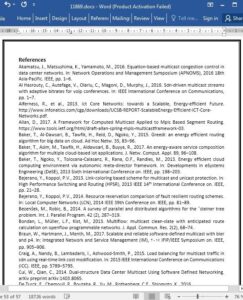Abstract
The emerging Software Defined Networking (SDN) paradigm is being adopted by the telecom industry since it enables flexible network resource allocation, configuration and management. Multicast is an essential and attractive service for a wide range of todays Internet applications for its bandwidth-preserving efficiency and flexibility. In a multicast, a data stream is delivered from single or multiple sources to a group of destinations simultaneously. SDN has potential to simplify multicast traffic engineering by leveraging the centralized nature of the network control plane, which provides a global view of the network that is built based on the real-time data gathered from network devices. This article aims to provide a comprehensive survey about the recent advances in Software Defined Multicasting. Specifically, it will provide an overview of multicasting in the context of SDNs, discuss tree planning and management, discuss multicast routing and traffic engineering, reliability and scalability in routing and multicast techniques in data centers. It will also summarize key techniques for each important topic related to multicasting that can enable researchers and practitioners to quickly get started. Finally, we identify open challenges for SDN multicasting and outline future research directions.
1. Introduction
According to latest IT industry analysis, the global market for Software Defined Networking (SDN) has recorded a remarkable annual growth rate of 88.1% in five years period only. The market has reached 2.4 $ billion in 2015 and is expected to reach 56.1 $ billion in 2020 (Gijare, 2016). SDN is a new networking paradigm that has been adopted by dominant internet companies like Google and Facebook for their Data Center Networks structure and their connections in Wide Area Networks (De Turck et al., 2016). It was first introduced to overcome the lack of programmability and scalability in network management and configuration that are faced in the traditional IP networks. Although traditional networks are widely adopted, requirements such as: dynamicity, flexibility, and easiness in management and configuration are challenging to achieve in such networks. This makes them unattractive networking solution especially with the evolution of the Internet and the newly evolving technologies that require higher bandwidth, accessibility, increased network programmability and agility. Examples of such technologies are: mobile networking, cloud computing, network function virtualization, social networking, and multimedia applications (Masoudi and Ghaffari, 2016).
9. Conclusion
In this paper, a systematic survey of multicasting in software-defined net-working was presented. The goal of this survey was to study different aspects of multicasting in SDN and try to cover all the related challenges to each aspect and the existing solutions to overcome those challenges. First, the importance of software defined networking was introduced while highlighting the features of SDN that can be utilized to improve the quality of multicasting. Then multicasting techniques were surveyed starting from the history and background of multicasting. After that the existing solutions for multicasting main fields of interest were presented such as: tree planning, tree management, multicast routing, multicast TE and multicast in data centers. Comparisons were conducted between the different existing solutions/techniques that were introduced in the paper. Moreover, future research directions were suggested to improve the existing solutions or to highlight new problems that were not studied earlier.











